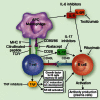The effect of targeted rheumatoid arthritis therapies on anti-citrullinated protein autoantibody levels and B cell responses
- PMID: 23607804
- PMCID: PMC3694530
- DOI: 10.1111/cei.12114
The effect of targeted rheumatoid arthritis therapies on anti-citrullinated protein autoantibody levels and B cell responses
Abstract
Rheumatoid arthritis (RA) is a complex inflammatory disorder associated with synovitis and joint destruction that affects an estimated 1·3 million Americans and causes significant morbidity, a reduced life-span and lost work productivity. The use of biological therapies for the treatment of RA is costly, and the selection of therapies is still largely empirical and not guided by the underlying biological features of the disease in individual patients. The synovitis associated with RA is characterized by an influx of B and T cells, macrophages and neutrophils and the expansion of fibroblast-like synoviocytes, which form pannus and lead to cartilage and bone destruction. RA is associated with synovial production of rheumatoid factor (RF) and anti-citrullinated protein autoantibodies (ACPA) and with the production of inflammatory cytokines, including interleukin (IL)-1, IL-6, IL-17 and tumour necrosis factor (TNF)-α, which are targets for RA therapeutics. Recent ideas about the pathogenesis of RA emphasize a genetic predisposition to develop RA, a preclinical phase of disease that is associated with the production of ACPA and the development of symptomatic disease following inflammatory initiating events that are associated with expression of citrullinated epitopes in the joints of patients. However, we still have a limited understanding of the cytokine and intracellular pathways that regulate ACPA levels. In humans, therapy with biological agents affords a unique opportunity to better understand the cytokine and signalling pathways regulating ACPA levels and the impact of ACPA level changes on disease activity. In this study we summarize the effect of RA therapies on ACPA levels and B cell responses.
© 2013 British Society for Immunology.
Figures


References
-
- Levesque MC, Zhou Z, Moreland LW. Anti-CCP testing for the diagnosis of rheumatoid arthritis and the quest for improved sensitivity and predictive value. Arthritis Rheum. 2009;60:2211–2215. - PubMed
-
- Schellekens GA, Visser H, de Jong BA, et al. The diagnostic properties of rheumatoid arthritis antibodies recognizing a cyclic citrullinated peptide. Arthritis Rheum. 2000;43:155–163. - PubMed
-
- Gregersen PK, Silver J, Winchester RJ. The shared epitope hypothesis. An approach to understanding the molecular genetics of susceptibility to rheumatoid arthritis. Arthritis Rheum. 1987;30:1205–1213. - PubMed
Publication types
MeSH terms
Substances
LinkOut - more resources
Full Text Sources
Other Literature Sources
Medical

